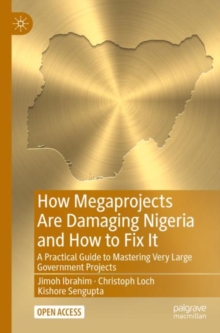Description
| Product ID: | 9783030964764 |
| Product Form: | Paperback / softback |
| Country of Manufacture: | GB |
| Title: | How Megaprojects Are Damaging Nigeria and How to Fix It |
| Subtitle: | A Practical Guide to Mastering Very Large Government Projects |
| Authors: | Author: Christoph Loch, Kishore Sengupta, Jimoh Ibrahim |
| Page Count: | 240 |
| Subjects: | Central / national / federal government, Central government, International business, Project management, International business, Project management, Nigeria |
| Description: | Select Guide Rating Since 1960, two-thirds of very large governmental projects in Nigeria have not only failed, but been abandoned mid-course. This presents a bigger failure rate than mega projects elsewhere, and yet there is no available data or analysis to help us understand the reasons behind such failures. This book provides an authoritative examination into why very large projects in Nigeria have failed so badly, and provides practical recommendations on how the Nigerian government can improve its project performance. Drawing on data from 38 very large projects (19 completed and 19 abandoned) with a total budget of over $25B, this book presents detailed analysis of these projects and in-depth case studies 11 of the projects, and presents lessons for improvement. Through this, the authors have identified a small number of key success drivers, and argue that making moderate improvements on any of them would, on average, save hundreds of millions of dollars on one large project alone. This book is a game-changer in the management of government mega projects in Nigeria. With clear implications for other developing economies, this is a vital resource for project management practitioners, executives and civil servants. This is an open access book. 1 Introduction: The Project Abandonment Problem. References. 2 What We Know About the Management of Very Large Projects. 2.1 Project Success Factors as Lists. 2.2 The Project Success Frameworks of Miller and Lessard and Morris and Hough. 2.2.1 Miller and Lessard (2000). 2.2.2 Morris and Hough (1987). 2.3 The Nigerian Context. 2.4 The Extended Theoretical Framework. 2.5 What About Corruption?. References. 3 Structure of the Investigation. 3.1 Overview of the Approach Taken in This Study. 3.2 Construction and Execution of the Survey. 3.3 Construction of the Sample of Projects. 3.4 Construction of the Case Studies. Appendix: Full Questionnaire as It Was Administered. Our Request. Project Variables. References. 4 A Description of the 38 Matched Projects. 4.1 Lagos-Ibadan Express Road. 4.2 Lagos-Badagry Express Road. 4.3 Third Mainland Bridge. 4.4 Second Niger Bridge. 4.5 Egbin Power Station. 4.6 Calabar Power Station. 4.7 Zungeru Hydropower Plant. 4.8 Delta State (Oghareki) Power Plant. 4.9 Shiroro Hydroelectric Power Station. 4.10 Omoku Power Plant Station. 4.11 Mambilla Hydroelectric Power. 4.12 Ajaokuta Steel Project. 4.13 Kanji Dam. 4.14 Otukpo Dam. 4.15 Nigeria Satellite 2. 4.16 Nigeria Satellite 1. 4.17 Airtel Nigeria. 4.18 Nigerian Telecommunications Limited (NITEL). 4.19 Godswill Akpabio International Stadium. 4.20 (Samuel) Ogbemudia Stadium. 4.21 Abuja International Airport. 4.22 Lagos MMA2 Airport. 4.23 Yenagoa International Cargo Airport. 4.24 Jigawa Airport Project. 4.25 Tin Can Island Port. 4.26 Calabar Seaport. 4.27 Victoria Garden City (VGC) Housing Estate. 4.28 Festac Town Federal Housing Estate. 4.29 1004 Housing Estate. 4.30 Abuja Mass Federal Housing Project. 4.31 Olusegun Obasanjo Presidential Library. 4.32 Abuja National Library. 4.33 Nigerian Youth Empowerment Scheme (N-Power). 4.34 Nigeria Subsidy Reinvestment and Empowerment Programme (SURE-P). 4.35 Lagos State Waste Management Authority (LAWMA). 4.36 Cleaner Lagos Initiative (Visionscape). 4.37 University College Teaching Hospital (UCH) Ibadan. 4.38 University of Abuja Teaching Hospital (UATH). References. 5 Insights from the Analysis of the Questionnaires. 5.1 Variable Distributions and Variable Capability to Detect Differences Across Projects. 5.1.1 Each Respondent Type Adds Unique Perspectives and Information. 5.1.2 The Variables Capture Robust Differences Between Abandoned and Completed Projects. 5.2 Condensing Variables into Aggregated Success Factors. 5.2.1 Approach. 5.2.2 Identifying the Factors. 5.3 Econometric Prediction of Project Completion. 5.4 Econometric Prediction of Cost and Schedule Overruns for Completed Projects. 5.4.1 Effect of Variables on Budget Overruns. 5.4.2 Effect of Variables on Schedule Overruns. 5.5 The Corrosive Effect of Corruption. Appendix 1 Correlations Among Independent Variables Across All 114 Responses. Appendix 2 Factor Analysis. Appendix 3 Specification of the Logistical Regression. Appendix 4 The Logistical Completion Probability Regression by Respondent Group. Appendix 5 Robustness Analysis: Cost Overrun Regressions by Respondent Group. Appendix 6 Robustness Analysis: Schedule Overrun Regressions by Respondent Group. 6 Two Library Projects. 6.1 The National Library of Nigeria in Abuja: An Abandoned Project.6.1.1 Project Initiation. 6.1.2 Contract Signature and Execution. |
| Imprint Name: | Springer Nature Switzerland AG |
| Publisher Name: | Springer Nature Switzerland AG |
| Country of Publication: | GB |
| Publishing Date: | 2022-05-13 |


